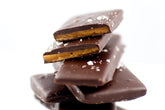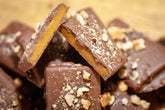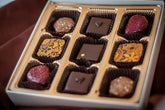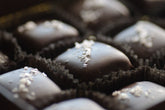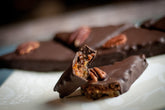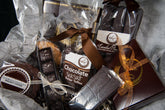Chocolate at the James Beard House
As you can tell I’m still playing catchup from the end of the 2011 holiday season. During which we were asked by Chef Joe Bonaparte of the International Art Institute to help him with a part of the James Beard New Year Dinner.
For those that do not know of James Beard, his foundation and dining experience..
A cookbook author and teacher, James Beard was a champion of American cuisine who helped educate and mentor generations of professional chefs and food enthusiasts. Today, the Beard Foundation continues in the same spirit by offering a variety of events and programs designed to educate, inspire, entertain, and foster a deeper understanding of our culinary culture. <…>
To celebrate, nurture, and preserve America’s diverse culinary heritage and future.
Least to say we were very honored to be asked to participate.

Chocolate Foie Grais
Chef Bonaparte wanted to bring a little something special to the attendees of the Beard house and decided upon using Hudson Valley Foie Gras. If you haven’t ever had foie gras (and in this case it’s a duck liver) you should find a chef that can source it and prepare it well. Chef went with a quick curing with port wine, salt and pepper. A very simple treatments to something which can be a prize unto itself. If you’ve never had foie grais it may be a love or hate idea, it’s very earthy, very thick, robust, full bodied. Just a bit at a time will do.
Finding the Chocolate to Fit
Over an afternoon we discussed and sampled a number of dark chocolates ranging from 60-80% to coat the foie gras. Like many of our own chocolates we understand that you don’t want other flavors competing with a presentation, and this was definitely something to present. In the end we decided to go with our TCHO 60.5% blend, the heart of most of our chocolate ganaches. It brought out the perfection of chocolate but did not get in the way of a wonderfully prepared foie grais. We then decided that the same sea salt (Murray River out of Australia) would be a great compliment bringing out the sweetness in both the chocolate and foie grais.

Cutting, Dipping, Sampling, Enjoying
A few weeks rolled by our season came and it began to ebb. Chef Bonaparte’s foie gras was delivered and he gave it the preparations he wanted to. We came together during one of our closed days, prepped a work environment, setup our chocolate tempering machine and began to do something we don’t often do–dip a protein.
The duck was chilled and Chef cut it into exacting shapes, then chilling it again to remain in shape. When foie gras gets warm it becomes tacky and gooey–good for eating but not good for dipping. We’re used to the process with our ganache but this was even more temperamental. We got through them all, with a few missing for quality control–a delicious job.
A Toast to Chocolate Truffles
Wrapped and packed we went on to our next job. We’re also going to be sending our chocolate truffles for the midnight toast paired with Shelton Vineyards Blanc de blanc (out of NC’s Yadkin Valley.) With the help of Anita Skogland, a wine instructor and connoisseur she helped us pick out a coconut chocolate truffle and chai tea chocolate truffle to be sent along.
Blanc de blanc’s tend to be light and dry–citrus, floral, clean–made only with a chardonay. Our coconut truffle is made with coconut cream instead of a dairy cream with a little toasted coconut for texture and our chai is an organic masala blend. A light and island sweet and a spicy tea would go great with something so elegant.
The Evening Was Grand
While we would have loved to attend ourselves we could only live vicariously through text messages and a followup with Chef Bonaparte. The evening was a great success and everyone had a very enjoyable meal including our additions. We were glad to be included and set aside time to help with the event. Being something different from our usual routine we learned a lot and it was a joy to work with another Chef in our kitchen.



